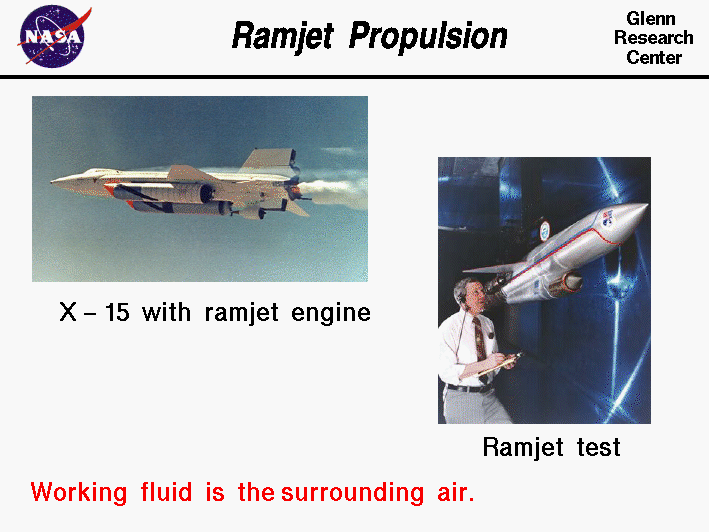
Thrust is the force which moves any
aircraft through the air. Thrust is generated by the
propulsion system
of the aircraft. Different propulsion systems develop thrust in
different ways, but all thrust is generated through some
application of Newton's third law of
motion. For every action there is an equal and opposite reaction.
In any propulsion system, a working fluid is
accelerated by the system and
the reaction to this acceleration produces a force on the system. A
general derivation of the thrust equation
shows that the amount of thrust generated depends on the
mass flow
through the engine and the
exit velocity
of the gas. Engineers use a
thermodynamic analysis
of the ramjet to predict thrust and fuel flow for
a particular design.
In the early 1900's some of the original ideas concerning
ramjet propulsion were first developed in
Europe. Thrust is produced by passing the hot exhaust from the
combustion of a fuel
through a nozzle.
The nozzle accelerates the flow, and the reaction to this
acceleration produces thrust. To maintain the flow through the
nozzle, the combustion must occur at a pressure
that is higher than the pressure at the nozzle exit. In a ramjet, the
high pressure is produced by "ramming" external air into the
combustor using the forward speed of the vehicle. The external air
that is brought into the propulsion system becomes the working fluid,
much like a turbojet engine. In a turbojet
engine, the high pressure in the combustor is generated by a piece of
machinery called a compressor. But there
are no compressors in a ramjet. Therefore, ramjets are lighter and
simpler than a turbojet. Ramjets produce thrust only when the vehicle
is already moving; ramjets cannot produce thrust when the engine is
stationary or static.
Since a ramjet cannot produce static thrust, some
other propulsion system must be used to accelerate the vehicle to a
speed where the ramjet begins to produce thrust.
The higher the speed of the vehicle, the better a ramjet works
until aerodynamic losses become a dominant factor.
The combustion that produces thrust in the ramjet occurs at a
subsonic speed in the combustor.
For a vehicle traveling
supersonically,
the air entering the engine must be slowed to subsonic speeds
by the aircraft
inlet.
Shock waves
present in the inlet cause performance losses for the propulsion
system. Above Mach 5, ramjet propulsion becomes very inefficient.
The new supersonic combustion ramjet, or
scramjet,
solves this problem by performing the combustion supersonically
in the burner.
Shown above are pictures of an X-15 rocket-powered airplane with a
ramjet slung underneath the body and a wind tunnel test of a ramjet
inlet used on a missile. In both propulsion
systems, a rocket is used to bring the ramjet up to speed before it
produces thrust. Because the ramjet uses external air for combustion,
it is a more efficient propulsion system for flight within the
atmosphere than a rocket, which must carry
all of its oxygen. Ramjets are ideally suited for
very high speed
flight within the atmosphere.
EngineSim
is an interactive Java applet which allows you to test the design of
ramjet engines. You can learn the fundamentals of ramjet engine
propulsion with the EngineSim simulator.
Activities:

Guided Tours
-
 Propulsion Systems:
Propulsion Systems:

-
 Ramjets:
Ramjets:

Navigation ..


- Beginner's Guide Home Page
|
